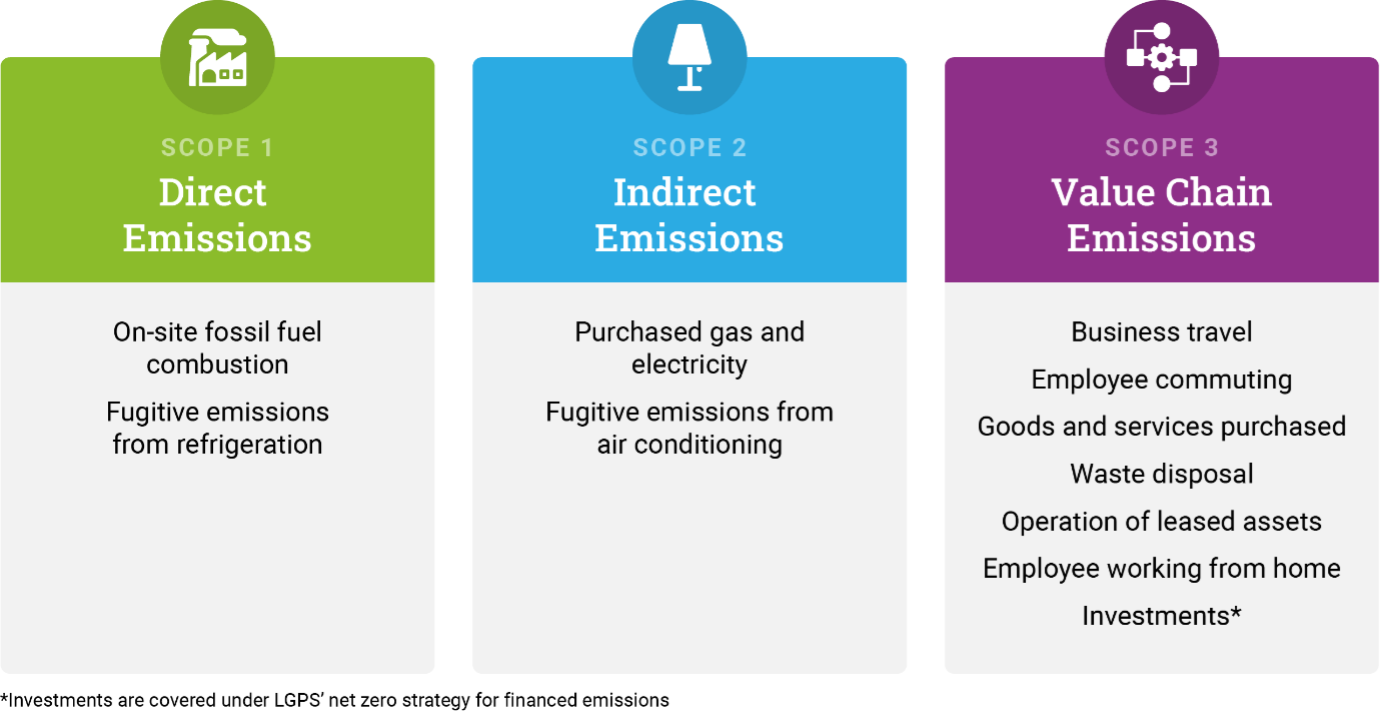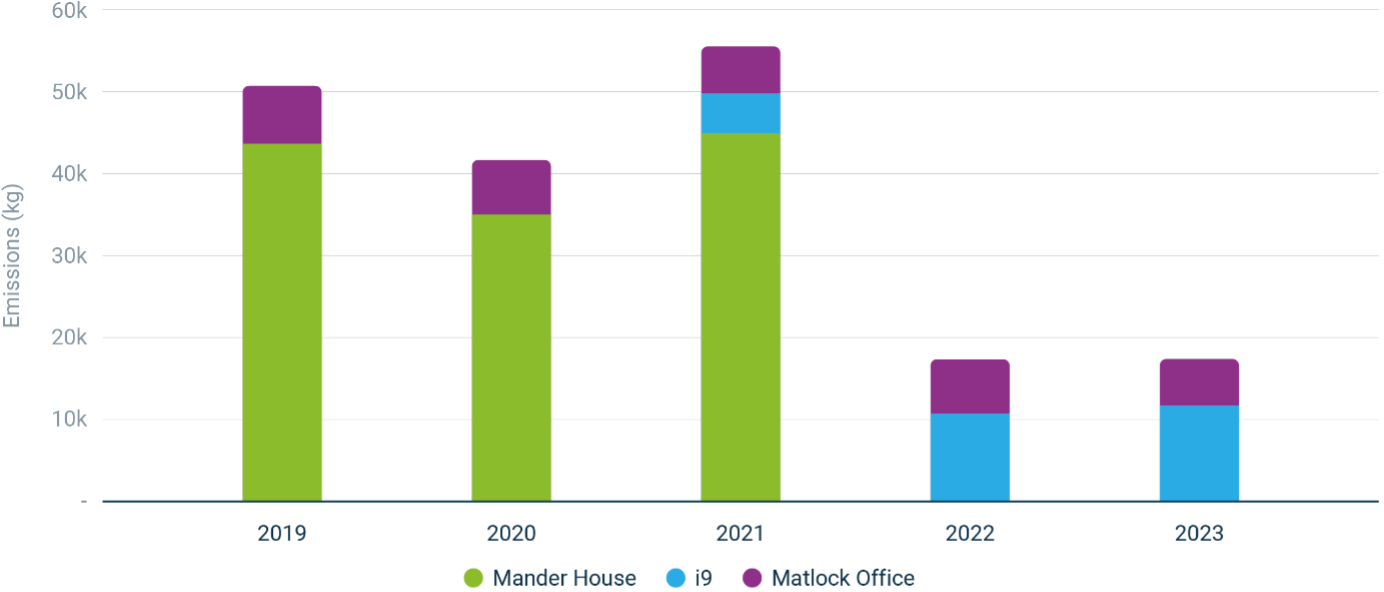Our Operational Net Zero Emissions
Part of our plan for achieving net zero financed emissions, includes reducing emissions associated with the running of the company. Whilst these emissions are small in comparison to those associated with our investments, they are nonetheless important to our continuing commitment to being a responsible investor.
Defining Operational Emissions
In line with the Greenhouse Gas Protocol (a globally recognised standard for measuring and managing greenhouse gas emissions and was established in 1990 out of the need for a consistent framework for greenhouse gas reporting).
An entity's emissions are categorised into three distinct scopes:
- Scope 1: direct emissions are from sources that are owned or controlled by the reporting entity.
- Scope 2: indirect emissions that occur as a result of company purchasing and use of energy
- Scope 3: all other sources of indirect emissions created by the company supply chain. Scope 3, the largest and most complex of these categories, breaks down into emissions that are upstream (i.e. purchased goods/services or inputs) and downstream of the company (i.e. disposed of goods or outputs) and 15 sub-categories.
The image below summarises the different sources of our operational emissions across all three scopes:

Our operational emissions target excludes emissions related to employees working from home and commuting to the office. This is due to current methodological challenges in accurately calculating them and also the distinction between corporate and individual responsibility. We will, endeavour to monitor these emissions and engage with colleagues to raise awareness and help reduce information barriers around potential solutions.
Our Strategy
In addressing these emissions, we will divide our approach into two phases:
- Phase one: near term actions to be completed by the end of 2025, such as switching to a 100% renewable energy contract, the annual purchasing of carbon allowance credits to account for essential business travel, amending expense forms to capture GHG emissions, staff questionnaire on commuting and working from home as well as an internal session on energy saving measures at home.
- Phase two: mid-term actions to be completed by the end of 2030, full value chain assessment of emissions (including embodied carbon in IT equipment, office furniture, waste disposal, fugitive emissions from air conditioning and refrigeration units). Monitoring and measuring of methodologies for assessing emissions related to employee commuting and working from home.
Our Efforts to Date
a) Scope 1 and 2 emissions (electricity and gas consumption)
We conducted an internal energy audit to understand the change in emissions from our consumption of electricity and gas since 2019. This involved reviewing electricity invoices and meter readings of our past (Mander House & Matlock) and present (i9) office buildings. For emissions associated with gas heating in our Mander House office, we obtained gas usage readings and converted them into associated CO2 emissions apportioned by floor space.
A baseline of 2019 was chosen, as to align with LGPSC’s Net Zero assets under management baseline. 2019 is also a year relatively unimpacted by economic lockdowns. The move in 2022 to a new office has resulted in a 65.9% decrease in measured scope 1 and 2 emissions.
Further emission savings are expected in 2025 following the closure of our Matlock office.

It should be noted that the above measurements do not include fugitive emissions (unintentional leaks or discharges of emissions) from air conditioning and refrigeration.
b) Business travel estimated emissions
We were able to produce an estimate of business travel-related emissions, following analysis of expense claims. Estimated trip lengths for car/taxis are derived from sample expense forms from the previous financial year. The trip lengths are multiplied by an emission factor for the average CO2 per mile estimate for a typical passenger vehicle. Emissions from air travel are estimated by the reported emissions of flight providers for LGPS Central’s likely furthest trips accounted for in the latest budget. To convert these emissions into a monetary cost, we used the greater year-high price of either the UK or EU (converted into GBP at the end of the same month) Emissions Trading Systems (ETS) Carbon Pricing.
Category |
Unit |
2019 |
2020 |
2021 |
2022 |
2023 |
Scope 1 & 2 operational emissions |
Kg/CO21 |
50,550 |
41,464 |
55,506 |
17,285 |
17,238 |
Business travel |
Kg/CO21 |
- |
- |
- |
- |
10,342 |
1The conversion of 0.19 CO2 kg / kWh is provided by Green Accountancy and is also supported by Carbon Independent (0.185 CO2 kg / kWh), while Bulb report a less intensive 0.183 CO2 kg / kWh.
In line with the two-phased approach set out above, in 2025, LGPS Central will switch to a clean energy2 electricity contract, further reducing scope 1 and 2 emissions.
For emissions related to essential business travel, we will purchase carbon allowance credits annually. We will regularly update stakeholders on our progress through our Task Force on Climate-related Financial Disclosures (TCFD) reporting and forthcoming standalone net zero progress report.
2Contracted electricity from wind, solar and hydro power sources.








